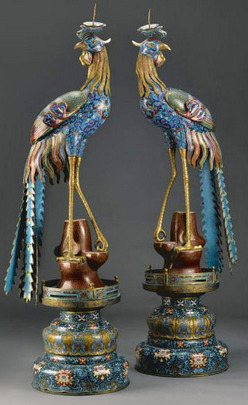Ename l (sometimes known as porcelain enamel, most properly termed vitreous enamel) is a very old technique, one which was used among the ancient Persians, Greeks, Celts, and Chinese, and refers to the process of fusing powdered glass to a base (normally metal, but also quite frequently a ceramic base, sometimes even a glass one, is used) by firing it to temperatures between 1,380-1,560 degrees Fahrenheit. At this temperature, the glass powder melts and vitrifies. (Vitreous has multiple meanings, at least two of which apply in this sense – glass-like and a shiny nonporous surface.) The powdered glass is either grounded colored glass or ground glass with pigments, normally metallic oxides, added.
l (sometimes known as porcelain enamel, most properly termed vitreous enamel) is a very old technique, one which was used among the ancient Persians, Greeks, Celts, and Chinese, and refers to the process of fusing powdered glass to a base (normally metal, but also quite frequently a ceramic base, sometimes even a glass one, is used) by firing it to temperatures between 1,380-1,560 degrees Fahrenheit. At this temperature, the glass powder melts and vitrifies. (Vitreous has multiple meanings, at least two of which apply in this sense – glass-like and a shiny nonporous surface.) The powdered glass is either grounded colored glass or ground glass with pigments, normally metallic oxides, added.
For most of its history, enamel has been used for decorative purposes – decorative objects like vases, urns, boxes, etc., and for jewelry. In the 19th century, manufacturers began producing industrial and household items that have also come to be referred to as enameled: bathtubs, sinks, washing machines, cookware.
There are a number of distinct techniques for applying enamel, but some of the most common decorative methods are painted, cloisonné, plique-à-jour, champlevé, and basse-taille. Painted enamel is exactly what it sounds like – painted onto a flat metal surface. Cloisonné enamel is enameled with the same material, but in cloisonné, a surface design is prepared with a design in a metal framework – not unlike a stained glass window – that is soldered to the surface and enamel is filled into those spaces. Cloisonné was originally a technique of inlaying precious and semi-precious stones into the surface of an object and enamel eventually replaced the stones but the concept of metal framing remained. Plique-à-jour is when a stained-glass-like frame is used, but not applied to a solid metal surface, leaving the back exposed and allowing light to shine through. Champlevé is a more cost-effective method and more suitable for larger works, where instead of applying enamel freehand to a surface or creating the framework cloisonné requires, the design is stamped, pressed, or etched into the surface of the metal and then the resulting compartments are filled with color. (Limoges enamel, in the earliest days, during the 12th century, were champlevé, with a later transition to the more straightforward technique of painted enamel.) Basse-taille, the one that is perhaps superior in artistry, is where the relief design is accomplished by the kind of craftsmanship that forms fine silver – engraving and chasing work to create relief designs and voids that are then filled with enamel.
Enamel is wonderfully durable and can be applied to virtually any metal. The finished product is scratch-resistant and, unlike paint, it’s won’t fade from exposure to light. Enamel works owe most of their vulnerability to the metal on which they are applied, because if the metal bends, the enamel surface will, of course, crack.
Enameling has been done for so long on so many surfaces and with such varying levels of skill that it’s difficult to make generalizations about the value of enamel-decorated pieces. Age is a significant factor, with older pieces typically having greater value, particularly if they are from high points in the art’s history – ancient China, early Limoges, etc. The subject or style of the decoration and the degree of detail and design in the work (cloisonné pieces often command large prices for these reasons as well) can also play a significant role in value.



